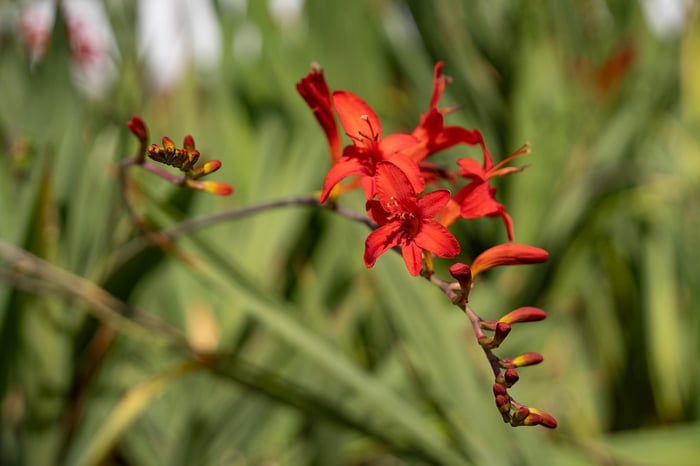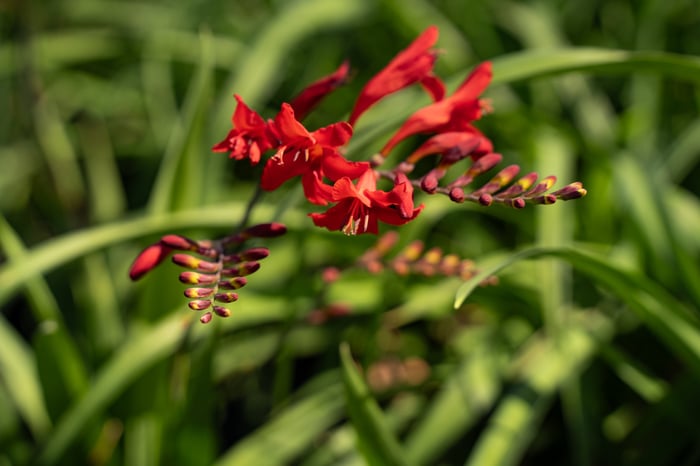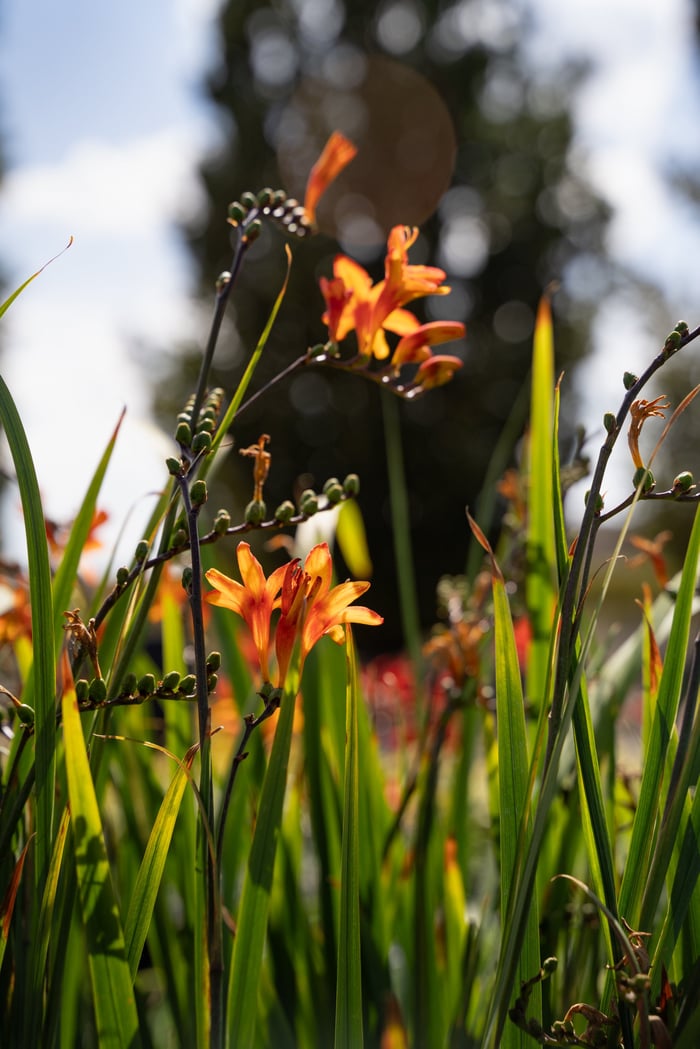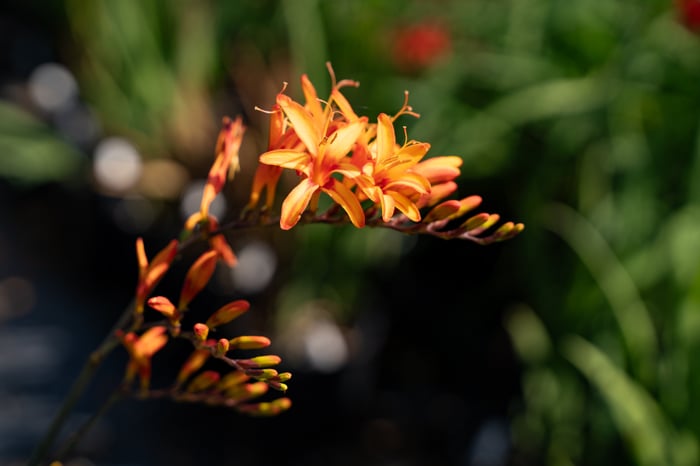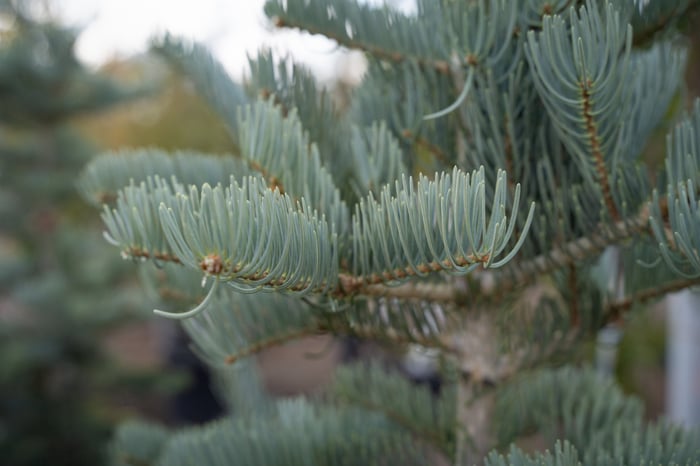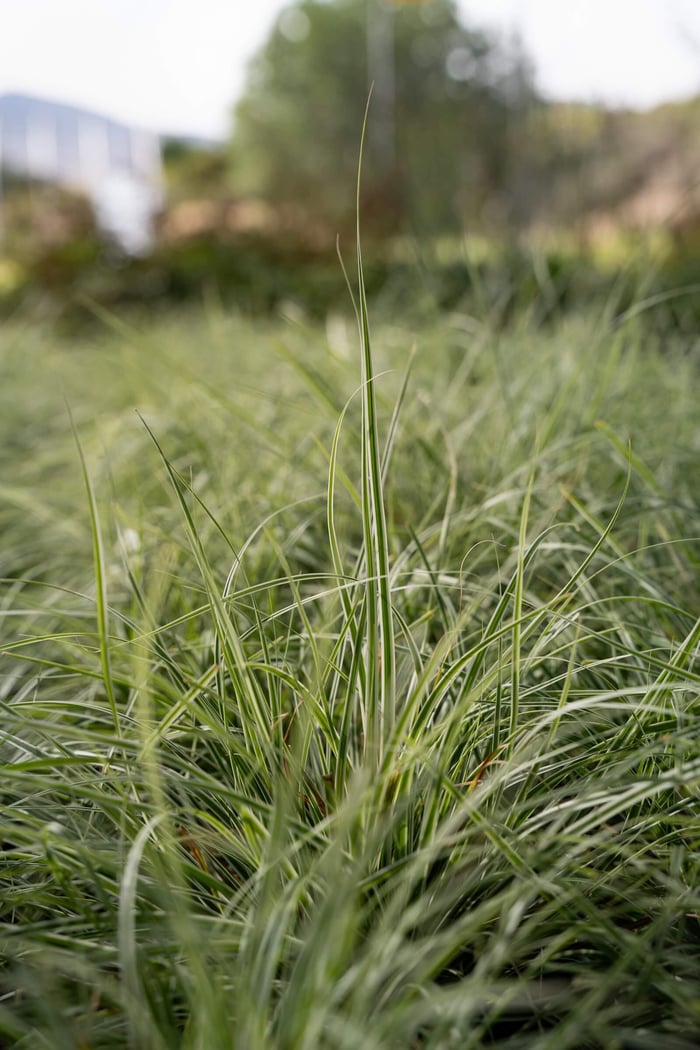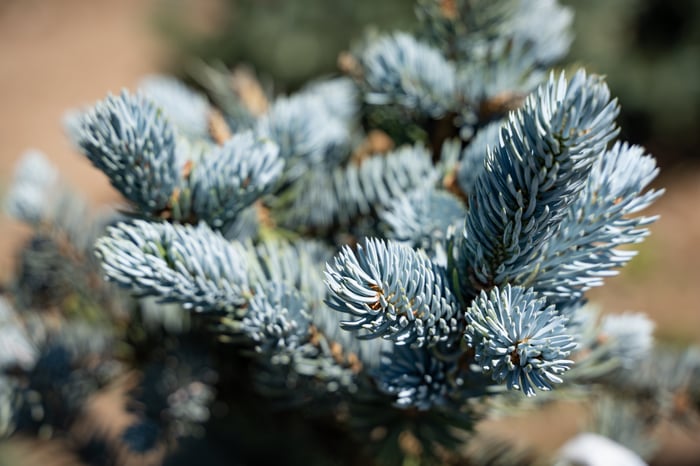Crocosmia, also known as Montbretia Falling Stars, is an excellent choice for gardens throughout the Intermountain West, including Utah, Idaho, Wyoming, and Colorado. This region's unique combination of high elevation, alkaline soils, and dramatic seasonal temperature swings requires plants that are both beautiful and resilient, and Crocosmia fits that description perfectly. Even better, it's very easy to grow. This low-maintenance, waterwise plant offers an effortless pop of fall color.
Crocosmia is a really cool plant! Its foliage resembles some varieties of iris, with tall thick leaf shafts that provide a nice bit of greenery throughout the growing season. However, that’s where the similarities stop. Crocosmia are summer blooming bulbs and their brightly-colored flowers grow on wiry, arching stems. It blooms from summer through fall with buds that open one-by-one from the bottom up. These red, orange, or yellow tubular flowers attract hummingbirds from all over the neighborhood.
Why This Plant Works in the Intermountain West
Climate Adapted: Crocosmia thrives in our region's hot summers, cold winters, and low humidity conditions.
Water Wise: This striking perennial isn’t too thirsty. It uses just a moderate amount of water, which is important for sustainable landscaping in our arid climate.
Soil Tolerance: Crocosmia adapts nicely to our region's alkaline conditions and varying soil types, so it will thrive in nearly any landscape.
How To Grow Montbretia Successfully in Our Climate
Site Selection & Elevation Considerations
In valley locations (4,000-5,500 ft), your crocosmia will do best in morning sun with some protection from the hot afternoon sun in summer. In higher mountain properties (5,500-8,000 ft), your Montbretia can typically handle more direct sun due to the cooler temperatures. It is also wise to consider wind exposure—our region's strong, dry winds can desiccate (dry out) plants quickly.
Soil Preparation
Most Intermountain West soils are alkaline (pH 7.0-8.5), which can be a challenge for some plants, but Crocosmia can handle the higher pH without issues. In the valleys, our soil is clay-heavy, and it tends to be sandy and rocky in the mountains. Since Crocosmia prefers soils that drain easily, improve drainage by adding compost and possibly even some coarse sand as you plant. Our poorly draining clay soils can become waterlogged in spring from snowmelt and rain, leading to root rot. Then, in the heat of summer, the clay can bake until it’s rock-hard. Adding organic matter to your soil will greatly improve drainage and help keep the soil soft in the heat. Be sure to top your garden beds with four inches of mulch to improve soil structure, reduce weeds, and retain moisture.
Watering Strategy
Establish a deep root system by watering thoroughly but infrequently. During establishment (first year), water 2-3 times per week. Once established, reduce to weekly watering or less, depending on rainfall and elevation. Use drip irrigation or soaker hoses to conserve water. Avoid overhead watering in alkaline soil areas to prevent leaf burn from mineral deposits.
Seasonal Care
Spring: Begin watering after the soil thaws and the snow has melted. That may be as early as March or April in the valleys and May at elevation, but watch your soil. Don’t water earlier than necessary. If the soil is still wet near your plants, you can delay watering. Apply compost and slow-release fertilizer if needed.
Summer: Maintain consistent moisture during our hot, dry period (July-September). Mulch to conserve moisture and cool roots.
Fall: Gradually reduce watering as temperatures drop.
Winter: Protect from drying winds with mulch or burlap screens if needed. Be sure to water your crocosmia a week or so before your ground freezes to prevent root desiccation..
Winter Protection
Our region's winter challenges include rapid temperature fluctuations, intense sun reflection off snow, and drying winds. Apply 3-4 inches of mulch around the base to protect the roots of your plants from drying.
Landscape Design Ideas
Valley Gardens: Use Montbretia Falling Stars in mixed borders with other water-wise plants. The alkaline clay soils support many Mediterranean and high desert species. Create seasonal interest by combining your Montbretia with spring bulbs and fall-blooming perennials.
Mountain Properties: Take advantage of cooler summers and dramatic seasonal changes. Pair with fall asters, goldenrod, caryopteris, zelkova, chokecherrys, or aspens for fall color. Add evergreens for winter color and structure. Rocky slopes provide excellent drainage for many alpine-adapted plants.
Water-Smart Design: Group plants with similar water needs. Place higher-water plants near the house or in naturally moist areas, with drought-tolerant species like Montbretia Falling Stars in outlying areas.
Perfect Plant Partners
We've selected these companion plants that share similar growing requirements and create beautiful combinations with Montbretia Falling Stars:
Rocky Mountain Upright Juniper (Juniperus scopulorum 'Blue Heaven') - Junipers are waterwise and evergreen, making them an excellent companion for your low-maintenance garden. This conifer will reach 15 - 20 feet tall and 10 - 12 feet wide. Shop Blue Heaven Rocky Mountain Upright Juniper
Rocky Mountain Upright Juniper (Juniperus scopulorum 'Blue Arrow') - For smaller garden beds, choose a narrower juniper like blue arrow for a nice vertical accent in your landscape. Shop Blue Arrow Rocky Mountain Upright Juniper
Goldenrod This stunning plant has similar water requirements and offers a pop of yellow in late summer and fall. Shop Goldenrod
Caryopteris Add a pop of deep blue to your summer and fall landscape with this stunning, waterwise plant. Shop Caryopteris
All of these plants are currently available at Progressive Plants and work wonderfully together in Intermountain West gardens.
Common Questions
How does elevation affect growing conditions?
Higher elevations mean cooler summers, earlier/later frosts, and more intense UV light. Plants often need less water at elevation but may require wind protection. Growing seasons are 4-6 weeks shorter above 6,000 feet.
Will this plant handle our alkaline clay soils?
Most plants adapted to the Intermountain West, including Montbretia Falling Stars, tolerate alkaline conditions well. The key is improving drainage - clay soils can be amended with coarse compost, sand, or even small gravel to prevent waterlogging.
How much water does it really need in our climate?
After establishment, water needs vary by location and elevation. Valley gardens typically need more irrigation due to heat and wind. Mountain locations may rely more on natural precipitation. Always water deeply but less frequently to encourage deep root growth.
Expert Tips
Timing: Plant in spring (after last frost) or early fall (6-8 weeks before first frost) for best establishment. Mulching: Use organic mulches in spring, but pull back from plant bases in fall to prevent rodent damage. Wind Protection: Young plants especially benefit from temporary windscreens their first winter. Local Microclimates: South-facing slopes warm earlier but also face more winter stress in terms of south winds and the potential to warm too much during the day only to freeze at night. This can lead to serious damage in some plants. Your Crocosmia should adapt just fine in these conditions as it will be dormant during winter.
If you’d like to add Montbretia Falling Stars or any other pop of color to your fall landscape, visit progressiveplants.com and start using the Garden Planning tool in our catalog search page. The tool is designed to make designing the ideal landscape for your space simple and easy. We’re open year round to answer any questions you may have. Visit Progressive Plants to see healthy, locally-adapted specimens and get personalized advice for your specific location and growing conditions.

